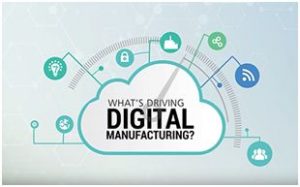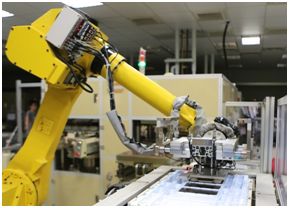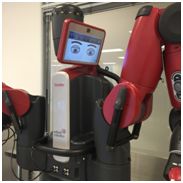
How digital manufacturing will shift production from the factory to your kitchen table
By Rush LaSelle, director of automation, Jabil Circuit Inc.
Automation / Robotics Contract Manufacturing Engineering digital manufacturing digital manufacturingWith the rapid pace of technological innovation, the need for greater market responsiveness, and the rising cost of labor in nearly all economies, many companies are revisiting age-old manufacturing strategies. They recognize there is a growing need to introduce innovative products faster to meet customer demands while maintaining aggressive cost and quality objectives. Traditional manufacturing approaches can no longer keep pace with this dynamic new consumer-driven age. Meeting these demands will instead require a complete reinvention to how we approach manufacturing, and this reinvention will need to unfold on a scale that amounts to a new industrial revolution.
Welcome to the era of digital manufacturing, which can be defined simply as the growing application and impact of digital connectivity linking automation, workers and decision-makers.
Greater connectivity on the factory floor
Several converging trends are driving this need for greater connectivity on the factory floor, starting with the parallel trend toward connectivity on the buy side. Digital technology today has empowered consumers to research, shop, compare and order products online, and increased pressure on brand owners to accelerate the pace of their new product development from concept through commercialization. Similarly, the concept of mass customization that allows consumers to select and “build” their own, personalized products online – while still in its infancy –is also forcing manufacturers to step up their game when it comes to production speed and flexibility.
On the supply-side, rising labor costs and dwindling labor pools are driving adoption of increasingly sophisticated robotics and automation. In some cases, the extreme miniaturization of products –specifically computing components – has made automation the only viable option when it comes to assembling tiny and even microscopic systems. Lastly, collapsing product lifecycles are shrinking the time-to-market window, while increasing the need to reduce production-line downtime, accelerate changeovers, elevate production efficiencies and improve predictability.
Digital manufacturing shortens reaction and production times
Market dynamics, shifting employment pools and technology almost overnight have transformed manufacturing from being simply a producer of goods to a service business. Put simply, the overall aim of digital manufacturing is to shorten reaction and production times while maximizing quality and cost-effectiveness. It also paves the way for the “democratization” of product design and development down the road. In the near future, digital manufacturing will enable other benefits, that include:
* More agile manufacturing operations that can adjust quickly and automatically to production changeovers
* More effective root-cause corrective action, via the use of such tools as predictive analytics to minimize production downtime
* Improved overall equipment effectiveness (OEE), overall line effectiveness (OLE) and first-pass yield (FPY)
* Enhanced ability to address growing consumer expectations for mass customization by offering build-to-demand products and, increasingly, next-day delivery
Despite the fast-growing demand for more agile production, the digital manufacturing revolution will not unfold overnight. It will require a four-phase approach beginning with the optimization of manufacturing infrastructure for efficiency, integrating and standardizing connectivity between machines and decision-makers, managing the subsequent increase in data flow and eventually applying this single-facility model to the entire enterprise.
Phase 1: Making the factory hyper-efficient
At its core, Phase 1 focuses on improving the factory’s overall efficiency by benchmarking equipment performance and replicating best processes across all machines. This has traditionally been a time-consuming manual process rife with uncontrolled variables. Combined with the fact that disparate equipment and bespoke control systems using varying protocols may sit alongside one another on the factory floor, the traditional approach can make for a veritable manufacturing soup.
True, manufacturers have always sought to optimize equipment. But, in the past, the singular products they produced had comparatively long life cycles, so benchmarking and reprogramming machines was not a frequent task. In comparison, digital manufacturing aims to gear the factory for frequent and nimble shifts from one product to another, with minimal trade-offs in cost or quality. Phase 1 then aims to do more than simply optimize the efficiency of the factory. It seeks to establish standard protocols for optimization that can be quickly ramped up for frequent product shifts.
Jabil’s SIM (Standard Integration Module) program offers an example of such automation standardization initiatives. The program’s goal is to create standard modules on a common platform that allows the replication of optimized machine programs across all work cells. This reduces the cost of deploying automated solutions while allowing a company’s assets to be redeployed as rapidly as direct labor
Standardized hardware and a unified software architecture
SIM reuses automation solutions based on standardized hardware and a unified software architecture that significantly reduces the time, costs and risks associated with implementing automation as a key production tool. Having designed a foundation of standard platforms and a software library, Jabil is able to deliver advanced process capabilities with industry-leading speed. By not having to develop each and every automated application from the ground-up, our customers can realize lower costs, higher quality, and faster time to market.
Phase 1 is also the time to introduce new manufacturing technologies to help make the factory floor more efficient. Some of the cutting-edge tools emerging today include augmented reality, collaborative robotics, sensor-driven optical inspection tools, and 3-D printing/additive manufacturing. All will help to support the shift to high-efficiency precision manufacturing.
Phase 2: Digitizing the factory enterprise
Phase 2, in a nutshell, is where manufacturers build that “last mile” of proverbial fiber to the factory floor to allow two-way information flow from machines to decision-makers. It will coincide with the growing application of sensors, giving rise to the Industrial Internet of Things (IIoT) and the merging of the cyber and physical worlds.
The goal is to create digital traceability along the entire supply chain – from raw materials to finished products – and to develop more flexible automation solutions that enable nimble production. Such traceability can yield tremendous benefits in any production scenario, but it assumes even more value in high-stakes industries such as aerospace and medical.
As the sophistication of sensor technology – ranging from machine vision to temperature, pressure and other physical sensing modalities – has soared, the cost of such sensors has also dropped precipitously. So now, rather than being a barrier to Phase 2, sensors have become more of an enabler. Their proliferation is making it easier than ever to capture data about the conditions and actions of nearly any type of machine, and increasingly enable different machines types to be linked with one another.
Interoperability of sensor networks
One major hurdle, however, is ensuring the interoperability of sensor networks and the data they carry. Different standards exist in North America, Europe and Asia, and sensor suppliers offer their own proprietary sets of solutions with differing middle-ware, plant-level controls and analytics software. A manufacturer or OEM also may need to further tailor its analytics in-house. Currently, the most common solution is a hybrid approach in which different networks from different suppliers are stitched together. However, standardization across sensor network platforms would go a long way to making Phase 2 simpler for manufacturers to implement.
In a perfect world, we’d be able to see down into every machine remotely to monitor and optimize it. By connecting machines at the local plant level, Phase 2 lays the groundwork for Phase 3, in which manufacturers must find a way to convert the rising tide of sensor data into actionable intelligence.
Phase 3: Converting factory data into factory intelligence
Phase 3 in the digital manufacturing revolution is all about dynamic process change. To offer a human analogy, once Phase 2’s backbone is present, Phase 3 builds the brain that can send and receive signals throughout the nervous system. The biggest, singular challenge of Phase 3 involves managing Big Data.
Sensors solve the question of how data are collected across the enterprise. But another fast-evolving technology – cloud computing – is helping to address the question of where to store it all for easy, universal access. The cloud offers an infinitely expandable network of remote Internet servers that allow enterprises to eliminate their expensive and increasingly inadequate in-house enterprise servers and adopt “computing as a service.”
With quickly scalable storage capabilities and the ability to transmit massive amounts of digital data across geographies in real-time, cloud services already are shaping the enterprise of the future. The cloud also holds the tools that enterprises will need to quickly and efficiently structure, analyze and convert all of that data into actionable intelligence. Yet even after one has all the tools to absorb these data, analyze them in real time and even tweak the settings on a key piece of production equipment, further challenges remain before this concept of dynamic process change can take place.
For example, consider that a manufacturer of an artificial heart valve or of a critical aircraft safety component may get one million data points off a machine on a given day. What safeguards exist to ensure that any dynamically made process tweak is a tolerable change to such a product? How does one ensure the product remains within the necessary, incredibly tight specifications?
Robots are able to more than they’ve been allowed to do
Robots are able to more than they’ve been allowed to do, and this value gap will only shorten as they are networked. However, the problem is that once commands are issued from a server, it raises the very real specter of potential safety and quality issues.
This is where machine learning in neural networks begins to apply. A so-called “smart” machine, by definition begins by taking data generated through its sensors and applies artificial intelligence (AI) to perform pattern-matching and predictive formulations from those reams of data, and apply them to help optimize processing. But for the reasons noted above, this AI solution will necessarily be applied first to the least-risky, high-tolerance operations, such as allowing process adjustments to move or reposition equipment in the factory.
As Phase 3 overcomes each of these challenges, the benefit will be an increasing ability to leverage advanced analytics, predictive insights, and simulation to enable real-time actionable insights to prevent situations before they occur.
The aim of predictive analytics is to eliminate, or at least greatly minimize the impact of unplanned machine downtime, which can be a productivity killer. As embedded sensors become more pervasive and networked, the volume and depth of data aggregated in a central network will make it more accessible and, ultimately, actionable.
Networked sensors will help drive predictive maintenance
Similarly, networked sensors will help drive predictive maintenance, which assesses the condition of in-service equipment to calculate when maintenance should be performed. Since tasks are performed only when warranted, this approach can lower costs compared to routine or preventive maintenance. By allowing convenient scheduling of corrective maintenance, it also aims to prevent unexpected equipment failures and avoid productivity disruptions.
Machine learning, a subfield of artificial intelligence, gives computers the ability to learn without being explicitly programmed. Machine learning can be thought of as a set of tools and methods that attempt to infer patterns and extract insight from observations made of the physical world. Two key areas of this field include reinforcement learning and deep learning.
Reinforcement learning involves programming by demonstration, or “lead through teach.” It is arguably the most tangible area of research for robotics today. Thus far, however, most of that research has focused on robots for services and humanoid robots rather than industrial robots used in factories. A widely publicized example of reinforcement learning is Baxter from Rethink Robotics which largely targets small companies that may not maintain a robot programmer on staff.
Deep Learning, in turn, mimics the activity in layers of neurons in the neocortex, the area of the brain where analytical thinking occurs. The system learns to recognize patterns in digital representations of data and constitutes a digital neural network. Simply put, deep learning offers increasingly sophisticated methods of creating predictive models using pattern recognition to solve complex problems. In an industrial setting, for example, image processing can improve visual inspection systems for manufacturers.
Phase 4: Linking intelligent factories into a distributed network
The forward-looking final phase of the digital manufacturing expands the intelligent factory concept to encompass multiple installations. Further out, this idea extends even beyond the OEM’s flagship assets to include micro-factories for consumers. Imagine fixing your cell phone on an internet-connected machine in your living room.
Phase 4 is really where AI pays dividends by connecting local or global production with individual consumers. It represents the true democratization of design and production, as manufacturers and consumers collaborate to define the finished product. Small firms and individuals will gain access to powerful software programs and expensive machines that they could never afford on their own. Hobbyists theoretically could be able to leverage some of the same tools and resources as a multinational corporation. As a result, the consumer can be more of a direct participant in the design, development and delivery of their own product.
Inevitably, one of the biggest challenges related to this vision of a highly networked factory may very well be how to establish intellectual property in a new manufacturing paradigm of mass customization. How does one control or enforce IP rights in a world where products are conceived by the consumer?
Various national and international initiatives, such as Germany’s Industrie 4.0, are working to address the real and potential challenges associated with this rise of cyber-physical systems and of global, borderless, networked, digital manufacturing. Real obstacles remain to be overcome, but the potential is thrilling.
Welcome to the next industrial revolution.





